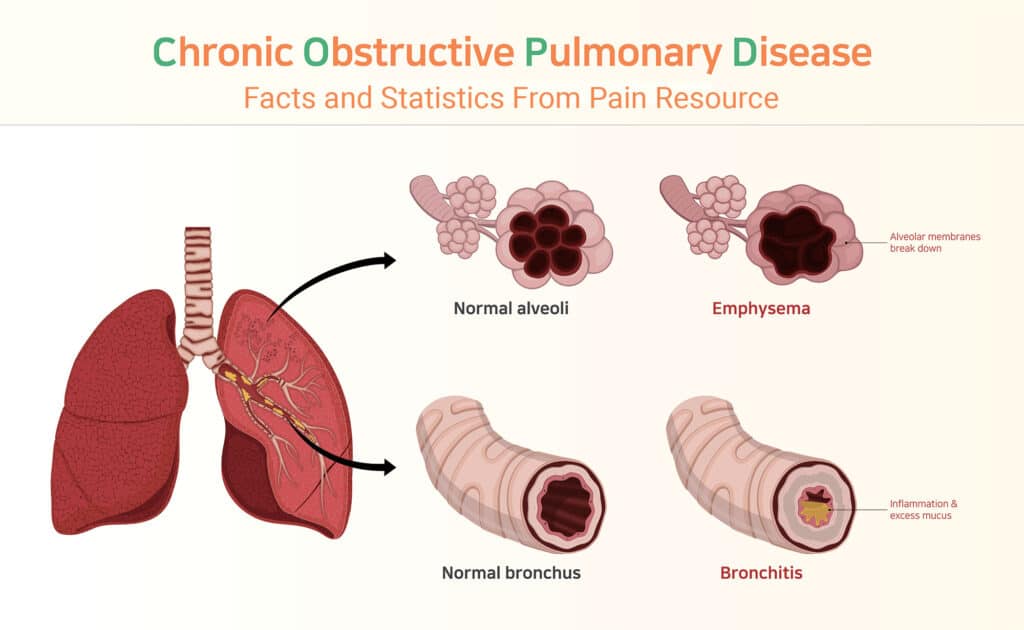As you may be aware, November is COPD Awareness Month. Initially started by the US COPD Coalition, COPD Awareness Month hopes to spread awareness of and raise support for finding new treatments for chronic obstructive pulmonary disease, or COPD, a chronic lung disease that affects about 175 million people worldwide.
According to the American Lung Association, an estimated 15.3 million Americans suffer from COPD, and several additional millions likely have COPD and don’t even know it. Each November, the COPD community comes together to promote better understanding of COPD, in hopes of finding better ways to manage and treat COPD.
Early diagnosis and treatment can help people with COPD improve their quality of life and health. In order to help do our part for COPD awareness this month, we’ve compiled helpful information on COPD.
What Is COPD?
 During COPD Awareness Month, one of the most important things is spreading information. So let’s start off with the basics of this chronic health issue!
During COPD Awareness Month, one of the most important things is spreading information. So let’s start off with the basics of this chronic health issue!
Chronic obstructive pulmonary disease is a serious, progressive lung disease that damages the lungs and makes breathing difficult. COPD is an umbrella term for a variety of diseases that cause airflow blockage and breathing-related problems. The two primary forms of COPD are pulmonary emphysema and chronic bronchitis.
With COPD, less air flows through the airways—the tubes that carry air in and out of your lungs. COPD can result in serious, long-term disability and kills more than 120,000 Americans each year, making it the third leading cause of death in the US. Most cases of COPD can be prevented by reducing exposure to risk factors such as smoking and indoor and outdoor pollutants. While treatment can help manage symptoms of COPD, no known cure exists.
What Causes COPD?
The most common cause of COPD is exposure to air pollutants, such as toxic chemicals or cigarette smoke. In fact, smoking is the most common cause for COPD. According to numbers from the Centers for Disease Control and Prevention, it’s estimated that 20-30% of cigarette smokers will develop COPD in their lifetime. Smoking accounts for as many as eight out of 10 COPD-related deaths, and 38% of the nearly 16 million American adults who are diagnosed with COPD report being current smokers.
COPD can also be caused by breathing in secondhand smoke or other kinds of fine particles of polluted air. COPD has been seen to develop often in countries or cultures where people typically use open fires for cooking and heating. Globally, it is estimated that more than three million people died of the disease in 2015, accounting for five percent of all deaths in that year.
If you have a long-term exposure to workplace pollutants like toxic chemicals, dust, or fumes, you may also be at risk for COPD. But this COPD Awareness Month, it’s important to know that not all cases are caused by environmental factors. Certain genetic conditions, such as alpha-1 antitrypsin deficiency (AATD), can also increase your risk of COPD—even if you’ve never smoked.
What Are the Most Common COPD Symptoms?
Symptoms of COPD usually start out mild and progress slowly. Early symptoms might include occasional shortness of breath, a persistent cough, or occasional tightness in the chest. The most common symptoms of COPD are:
- Wheezing
- Shortness of breath
- Chronic coughing
- Feeling of tightness in the chest
- Blue-colored lips or finger nail beds from a lack of oxygen (cyanosis)
- Tendency to catch a lot of colds, flu and other lung infections like pneumonia
- Fatigue from struggling to breathe and a lack of oxygen
- Swelling in feet, legs and ankles
Shortness of breath can be an important symptom of lung disease. If you experience any of these symptoms, or think you might be at risk for COPD, it is important to discuss this with your doctor.
In the early stages of COPD, there may be no symptoms, or there may only be mild symptoms. As COPD worsens, the symptoms become more severe. Many people with undiagnosed COPD think their symptoms are just a normal part of aging. As a result, they don’t think to go to their doctor to investigate these symptoms. Because of this, an important part of COPD awareness month is spreading awareness of the need for individuals to undergo testing to see if they have COPD.
How Is COPD Diagnosed and Treated?
 COPD is diagnosed using a simple breathing test called spirometry. Spirometry is the most common type of pulmonary function or breathing test. This test measures how much air you can breathe in and out of your lungs, as well as how easily and fast you can blow the air out of your lungs. Chest X-rays, CT scans, and arterial blood gas analysis can also help to diagnose pulmonary emphysema or other problems related to the supply of oxygen to the lungs.
COPD is diagnosed using a simple breathing test called spirometry. Spirometry is the most common type of pulmonary function or breathing test. This test measures how much air you can breathe in and out of your lungs, as well as how easily and fast you can blow the air out of your lungs. Chest X-rays, CT scans, and arterial blood gas analysis can also help to diagnose pulmonary emphysema or other problems related to the supply of oxygen to the lungs.
Most COPD treatments revolve around therapy and prevention techniques to keep COPD from worsening and prevent respiratory attacks. COPD treatment can alleviate symptoms, decrease the frequency and severity of respiratory issues, and increase exercise tolerance. However, COPD as a whole cannot be cured by current medicine.
While there currently is no cure for COPD, early diagnosis and treatment can greatly improve quality of life. Pulmonary rehabilitation, a personalized treatment program that teaches you how to manage your COPD symptoms, is a common form of therapy that helps with COPD systems. Additionally, symptoms such as coughing or wheezing can be treated with medication such as bronchodilators, which relax the muscles around your airways and make breathing easier.
Why COPD Awareness Month Matters
16.4 million people in the US are diagnosed with COPD, and as many as 14 million people with COPD go undiagnosed. During COPD Awareness Month, people and organizations across America try to promote early testing for COPD in order to help people get the treatment and information they need to live healthier, longer lives.
In 2017, the National Heart, Lung, and Blood Institute implemented the first-ever COPD National Action Plan, a blueprint for a multi-faceted, collaborative fight against the disease. Developed at the request of the United States Congress with input from the broad COPD community, the COPD National Action Plan hopes to help promote the diagnosis and treatment of COPD in US citizens, hopefully preventing hundreds of thousands of deaths a year.
With nearly one in 10 people in the US at risk for COPD, it’s likely that somebody you know is dealing with COPD symptoms today. During the time of the COVID-19 pandemic, which weakens respiratory functions and increases the likelihood of pulmonary issues, COPD awareness is more important now than ever. This COPD Awareness Month, we invite you to reach out to those around you who are at risk for COPD and try to get them the help they need today.
What Information Do You Want to Share this COPD Awareness Month?
Tell us your thoughts in the comments below!
What topics related to COPD should we cover next?
Email us your ideas at info@painresource.com
Are you a member of our online community?
Join the fastest-growing chronic pain community by clicking here!

